Rufford Abbey.
Although frequently grouped along with Worksop, Welbeck, Clumber and Thoresby, Rufford was never actually a ducal seat. It gets classed as a Dukeries property because of its geographic location and family links.
Before the Norman Conquest, Rufford was the property of the Saxon Lord, Ulf. William the Conqueror gave the land over to Gilbert de Gand. His successor (also a Gilbert), founded a Cistercian abbey there in 1148. The English Pope, Adrian IV gave the blessing for the abbey in 1156, after which the villagers of surrounding Grimston, Cratley, Inkersall, and Rufford itself were evacuated to make way for the expanding abbey grounds.
In 1538 the abbey was dissolved after two agents for of the Crown, sent specifically for the purpose, brought dubious charges against Thomas Doncaster the seventh abbott. The only part of the abbey which remains today (2014) is the crypt, which later became the servants’ quarters, and the adjoining cellars.
After the dissolution the remains of the abbey, its grounds and three water mills, soon passed to George Talbot, 4th Earl of Shrewsbury in an exchange with the Crown for castles and properties in Ireland. When George’s grandson the 6th Earl of Shrewsbury married Bess of Hardwick the link between Rufford and the emerging “Dukeries” was forever sealed.
Starting in 1560 the old monastic buildings were gradually converted into a house. In 1626 Mary Talbot, daughter of the 6th Earl, inherited the estate which then passed to her husband upon her marriage to George Saville in 1590. The Savile family and their descendants would make it their home. Notable additions to the building were to be a new north wing in 1679, with reception rooms and a long gallery, and a large stable block. The property continued to be a family home to the Savile’s until 1938 when the third Baron Savile inherited the estate as a 12 year old minor and his trustees divided the property into lots for auction.
You can read more about The Dukeries on these links: Welbeck, Thoresby, Worksop, and Clumber, and more about Bess of Hardwick and her role in the formation of the Dukeries on THIS LINK. And more about World War 2 and the Dukeries on THIS LINK.
Labels: Earl of Shrewsbury, Elizabeth Hardwick, Rufford, Rufford Abbey, the Dukeries, World War 2







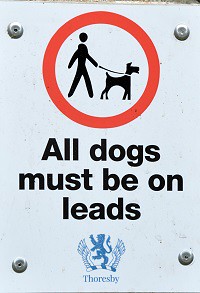 Thoresby Hall Hotel, Sherwood Forest and Clumber Park are recommended attractions for a day trip or short vacation. The
Dukeries area is of keen historic interest. NOTE: Apart from public domain postcards and brochures ALL photographs herein are copyright Ian Gordon Craig, exclusive permission granted to Thoresby Estate for their use elsewhere.
Thoresby Hall Hotel, Sherwood Forest and Clumber Park are recommended attractions for a day trip or short vacation. The
Dukeries area is of keen historic interest. NOTE: Apart from public domain postcards and brochures ALL photographs herein are copyright Ian Gordon Craig, exclusive permission granted to Thoresby Estate for their use elsewhere.
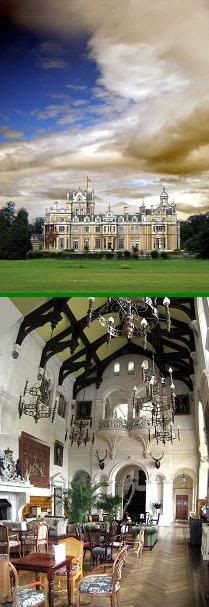 Thoresby Hall as photographed Summer 2009, now a successful Warners Hotel.
Thoresby Hall as photographed Summer 2009, now a successful Warners Hotel.
 Robert Pierrepont (1584 - 1643), 1st Earl of Kingston upon Hull, bought Thoresby for his second son William.
Robert Pierrepont (1584 - 1643), 1st Earl of Kingston upon Hull, bought Thoresby for his second son William.
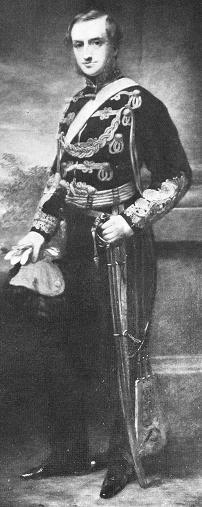 Sydney William Herbert Pierrepont (1825 - 1900), 3rd Earl Manvers, built the present Thoresby Hall, St John's Church,
Perlethorpe School, and generally shaped Thoresby Estate as it looks today.
Sydney William Herbert Pierrepont (1825 - 1900), 3rd Earl Manvers, built the present Thoresby Hall, St John's Church,
Perlethorpe School, and generally shaped Thoresby Estate as it looks today.
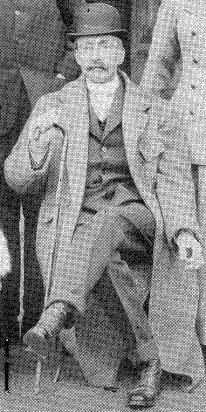 The 4th Earl Manvers (Died 1926).
The 4th Earl Manvers (Died 1926).
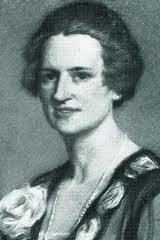 Countess Manvers (d.1984). Examples of her paintings are always on show at Thoresby Gallery.
Countess Manvers (d.1984). Examples of her paintings are always on show at Thoresby Gallery.
 ABOVE: The statue of Robin Hood in the courtyard at Thoresby Hall, by Tussaud - Birt, is showing its age, but remains one of
my favourites. The Art Gallery, crafts shops, and restaurant within that courtyard are recommended.
ABOVE: The statue of Robin Hood in the courtyard at Thoresby Hall, by Tussaud - Birt, is showing its age, but remains one of
my favourites. The Art Gallery, crafts shops, and restaurant within that courtyard are recommended.

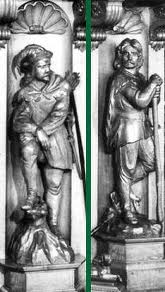
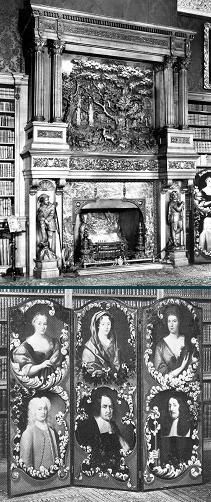 Carved oak fireplace in the Thoresby Hall library with its depiction of the Major Oak (Robin Hood's Tree), and the screen
featuring the Cromwell family. Oliver Cromwell is known to have stayed in Thoresby Hall before the English Civil War.
Carved oak fireplace in the Thoresby Hall library with its depiction of the Major Oak (Robin Hood's Tree), and the screen
featuring the Cromwell family. Oliver Cromwell is known to have stayed in Thoresby Hall before the English Civil War.
 The Green Bridge sited near the edge of the cricket pavilion in front of Thoresby Hall across which the Duke's carriage would take him to Perlethorpe Village.
The Green Bridge sited near the edge of the cricket pavilion in front of Thoresby Hall across which the Duke's carriage would take him to Perlethorpe Village.
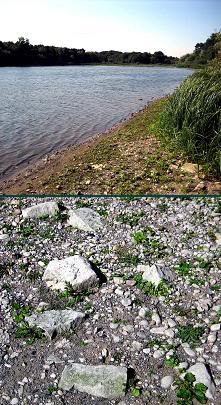 The view along Thoresby Lake towards Budby. Are these bricks at the water's edge remnants from the original Thoresby
Hall?
The view along Thoresby Lake towards Budby. Are these bricks at the water's edge remnants from the original Thoresby
Hall?
 The River Meden winds its way from 7 Ton Bridge near Thoresby Hall towards Perlethorpe Village.
The River Meden winds its way from 7 Ton Bridge near Thoresby Hall towards Perlethorpe Village.
 Budby Castle, once known as William Castle, and the River Meden winding towards Thoresby Lake under the remains of
Pierrepont Bridge, once described as classical and elegant.
Budby Castle, once known as William Castle, and the River Meden winding towards Thoresby Lake under the remains of
Pierrepont Bridge, once described as classical and elegant.
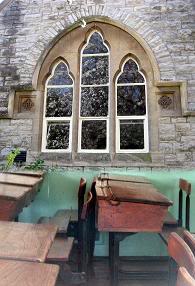
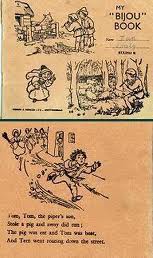 Children's exercise book from the school, 1958.
Children's exercise book from the school, 1958.
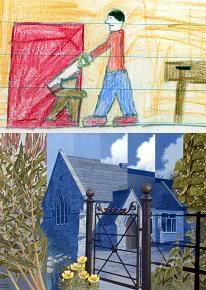
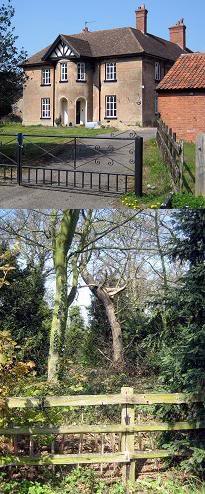



 Perlethorpe Church graveyard, where the original chapel once stood. The covered gate was a later addition in memorium to
the men of Budby and Thoresby who fell in World War 1.
Perlethorpe Church graveyard, where the original chapel once stood. The covered gate was a later addition in memorium to
the men of Budby and Thoresby who fell in World War 1.
 Robin Hood's Tree, the Major Oak, was once under the care and supervision of Thoresby Estate. Responsibility for its
upkeep changed to Nottingham City Council c.1969. Here it is pictured in in Spring, Autumn, and Winter.
Robin Hood's Tree, the Major Oak, was once under the care and supervision of Thoresby Estate. Responsibility for its
upkeep changed to Nottingham City Council c.1969. Here it is pictured in in Spring, Autumn, and Winter.

0 Comments:
Post a Comment
<< Home